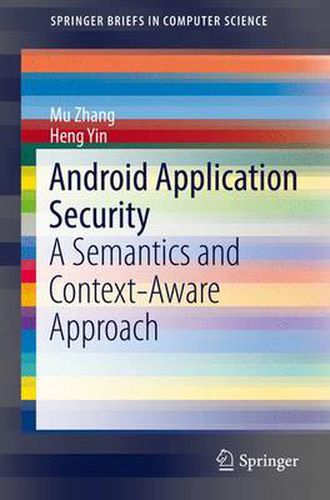Readings Newsletter
Become a Readings Member to make your shopping experience even easier.
Sign in or sign up for free!
You’re not far away from qualifying for FREE standard shipping within Australia
You’ve qualified for FREE standard shipping within Australia
The cart is loading…






This title is printed to order. This book may have been self-published. If so, we cannot guarantee the quality of the content. In the main most books will have gone through the editing process however some may not. We therefore suggest that you be aware of this before ordering this book. If in doubt check either the author or publisher’s details as we are unable to accept any returns unless they are faulty. Please contact us if you have any questions.
This SpringerBrief explains the emerging cyber threats that undermine Android application security. It further explores the opportunity to leverage the cutting-edge semantics and context-aware techniques to defend against such threats, including zero-day Android malware, deep software vulnerabilities, privacy breach and insufficient security warnings in app descriptions. The authors begin by introducing the background of the field, explaining the general operating system, programming features, and security mechanisms. The authors capture the semantic-level behavior of mobile applications and use it to reliably detect malware variants and zero-day malware. Next, they propose an automatic patch generation technique to detect and block dangerous information flow. A bytecode rewriting technique is used to confine privacy leakage. User-awareness, a key factor of security risks, is addressed by automatically translating security-related program semantics into natural language descriptions. Frequent behavior mining is used to discover and compress common semantics. As a result, the produced descriptions are security-sensitive, human-understandable and concise.By covering the background, current threats, and future work in this field, the brief is suitable for both professionals in industry and advanced-level students working in mobile security and applications. It is valuable for researchers, as well.
$9.00 standard shipping within Australia
FREE standard shipping within Australia for orders over $100.00
Express & International shipping calculated at checkout
This title is printed to order. This book may have been self-published. If so, we cannot guarantee the quality of the content. In the main most books will have gone through the editing process however some may not. We therefore suggest that you be aware of this before ordering this book. If in doubt check either the author or publisher’s details as we are unable to accept any returns unless they are faulty. Please contact us if you have any questions.
This SpringerBrief explains the emerging cyber threats that undermine Android application security. It further explores the opportunity to leverage the cutting-edge semantics and context-aware techniques to defend against such threats, including zero-day Android malware, deep software vulnerabilities, privacy breach and insufficient security warnings in app descriptions. The authors begin by introducing the background of the field, explaining the general operating system, programming features, and security mechanisms. The authors capture the semantic-level behavior of mobile applications and use it to reliably detect malware variants and zero-day malware. Next, they propose an automatic patch generation technique to detect and block dangerous information flow. A bytecode rewriting technique is used to confine privacy leakage. User-awareness, a key factor of security risks, is addressed by automatically translating security-related program semantics into natural language descriptions. Frequent behavior mining is used to discover and compress common semantics. As a result, the produced descriptions are security-sensitive, human-understandable and concise.By covering the background, current threats, and future work in this field, the brief is suitable for both professionals in industry and advanced-level students working in mobile security and applications. It is valuable for researchers, as well.